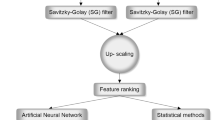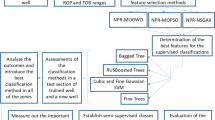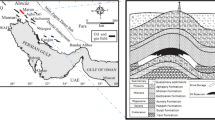Abstract
One of the important factors during drilling times is the rate of penetration (ROP), which is controlled based on different variables. Factors affecting different drillings are of paramount importance. In the current research, an attempt was made to better recognize drilling parameters and optimize them based on an optimization algorithm. For this purpose, 618 data sets, including RPM, flushing media, and compressive strength parameters, were measured and collected. After an initial investigation, the compressive strength feature of samples, which is an important parameter from the rocks, was used as a proper criterion for classification. Then using intelligent systems, three different levels of the rock strength and all data were modeled. The results showed that systems which were classified based on compressive strength showed a better performance for ROP assessment due to the proximity of features. Therefore, these three levels were used for classification. A new artificial bee colony algorithm was used to solve this problem. Optimizations were applied to the selected models under different optimization conditions, and optimal states were determined. As determining drilling machine parameters is important, these parameters were determined based on optimal conditions. The obtained results showed that this intelligent system can well improve drilling conditions and increase the ROP value for three strength levels of the rocks. This modeling system can be used in different drilling operations.









Similar content being viewed by others
References
Bhatnagar A, Khandelwal M (2012) An intelligent approach to evaluate drilling performance. Neural Comput Appl 21:763–770
Moraveji MK, Naderi M (2016) Drilling rate of penetration prediction and optimization using response surface methodology and bat algorithm. J Nat Gas Sci Eng 31:829–841
Miller D, Ball A (1990) Rock drilling with impregnated diamond microbits—an experimental study. In: International journal of rock mechanics and mining sciences & geomechanics abstracts. Elsevier, pp 363–371
Miller D, Ball A (1991) The wear of diamonds in impregnated diamond bit drilling. Wear 141:311–320
Rowlands D (1974) Rock fracture by diamond drilling. Ph.D. thesis, University of Queensland
Paona J, Bruce WE (1963) Drillability studies diamond drilling. Bur Mines, RI 6324
Chugh CP (1992) High technology in drilling and exploration. Balkema, Amsterdam
Yagiz S, Karahan H (2015) Application of various optimization techniques and comparison of their performances for predicting TBM penetration rate in rock mass. Int J Rock Mech Min Sci 80:308–315
Cheniany A, Hasan KS, Shahriar K, Hamidi JK (2012) An estimation of the penetration rate of rotary drills using the specific rock mass drillability index. Int J Min Sci Technol 22:187–193
Rostami J (2015) Performance prediction of hard rock tunnel boring machines (TBMs) in difficult ground. Tunn Undergr Sp Technol. https://doi.org/10.1016/j.tust.2016.01.009
Yagiz S (2002) Development of rock fracture and brittleness indices to quantify the effects of rock mass features and toughness in the CSM model basic penetration for hard rock tunneling machines. Ph.D. Thesis, Department of Mining and Earth Systems Engineering, Colorado School of Mines, Golden, Colorado, USA, p 289
John LP (1994) Influence of RPM and flushing media on the performance of diamond drilling, B. Tech
Paone J, Madson D (1966) Drillability studies: impregnated diamond bits. In: Department of the Interior, Bureau of Mines
Rao KU (1993) Experimental and theoretical investigation of drilling of rocks by impregnated diamond core bits
Rao KUM, Misra B (1994) Design of a spoked-wheel dynamometer for simultaneous monitoring of thrust and torque developed at the bit-rock interface during drilling. Int J Surf Min Reclam 8:145–152
Zhao Y, Yang H, Chen Z et al Effects of jointed rock mass and mixed ground conditions on the cutting efficiency and cutter wear of tunnel boring machine. Rock Mech Rock Eng doi.https://doi.org/10.1007/s00603-018-1667-y
Yang HQ, Li Z, Jie TQ, Zhang ZQ (2018) Effects of joints on the cutting behavior of disc cutter running on the jointed rock mass. Tunn Undergr Sp Technol 81:112–120
Ghaleini EN, Koopialipoor M, Momenzadeh M et al (2018) A combination of artificial bee colony and neural network for approximating the safety factor of retaining walls. Eng Comput 1–12
Koopialipoor M, Nikouei SS, Marto A et al (2018) Predicting tunnel boring machine performance through a new model based on the group method of data handling. Bull Eng Geol Environ 1–15
Hasanipanah M, Armaghani DJ, Amnieh HB et al A risk-based technique to analyze flyrock results through rock engineering system. Geotech Geol Eng 36:2247–2260
Gordan B, Koopialipoor M, Clementking A et al (2018) Estimating and optimizing safety factors of retaining wall through neural network and bee colony techniques. Eng Comput. https://doi.org/10.1007/s00366-018-0642-2
bib id="bib30">Hasanipanah M, Noorian-Bidgoli M, Jahed Armaghani D, Khamesi H (2016) Feasibility of PSO-ANN model for predicting surface settlement caused by tunneling. Eng Comput. https://doi.org/10.1007/s00366-016-0447-0
Chahnasir ES, Zandi Y, Shariati M et al (2018) Application of support vector machine with firefly algorithm for investigation of the factors affecting the shear strength of angle shear connectors. SMART Struct Syst 22(4):413–424
Sedghi Y, Zandi Y, Toghroli A et al (2018) Application of ANFIS technique on performance of C and L shaped angle shear connectors. SMART Struct Syst 22:335–340
Mansouri I, Safa M, Ibrahim Z et al (2016) Strength prediction of rotary brace damper using MLR and MARS. Struct Eng Mech 60:471–488
Sari PA, Suhatril M, Osman N et al (2018) An intelligent based-model role to simulate the factor of safe slope by support vector regression. Eng Comput. https://doi.org/10.1007/s00366-018-0677-4
Armaghani DJ, Mohamad ET, Narayanasamy MS et al (2017) Development of hybrid intelligent models for predicting TBM penetration rate in hard rock condition. Tunn Undergr Sp Technol 63:29–43. https://doi.org/10.1016/j.tust.2016.12.009
Armaghani DJ, Hajihassani M, Sohaei H et al (2015) Neuro-fuzzy technique to predict air-overpressure induced by blasting. Arab J Geosci 8:10937–10950. https://doi.org/10.1007/s12517-015-1984-3
Momeni E, Jahed Armaghani D, Hajihassani M, Mohd Amin MF (2015) Prediction of uniaxial compressive strength of rock samples using hybrid particle swarm optimization-based artificial neural networks. Meas J Int Meas Confed. https://doi.org/10.1016/j.measurement.2014.09.075
Armaghani DJ, Mohamad ET, Momeni E et al (2016) Prediction of the strength and elasticity modulus of granite through an expert artificial neural network. Arab J Geosci 9:48
Mansouri I, Shariati M, Safa M et al (2017) Analysis of influential factors for predicting the shear strength of a V-shaped angle shear connector in composite beams using an adaptive neuro-fuzzy technique. J Intell Manuf. https://doi.org/10.1007/s10845-017-1306-6
Hasanipanah M, Shahnazar A, Amnieh H (2017) Prediction of air-overpressure caused by mine blasting using a new hybrid PSO–SVR model. Eng Comput. https://doi.org/10.1007/s00366-016-0453-2
Armaghani DJ, Hasanipanah M, Amnieh HB, Mohamad ET (2018) Feasibility of ICA in approximating ground vibration resulting from mine blasting. Neural Comput Appl 29:457–465
Mojtahedi SFF, Ebtehaj I, Hasanipanah M et al (2018) Proposing a novel hybrid intelligent model for the simulation of particle size distribution resulting from blasting. Eng Comput. https://doi.org/10.1007/s00366-018-0582-x
Amiri M, Amnieh HB, Hasanipanah M, Khanli LM (2016) A new combination of artificial neural network and K-nearest neighbors models to predict blast-induced ground vibration and air-overpressure. Eng Comput 32:631–644
Toghroli A, Mohammadhassani M, Suhatril M et al (2014) Prediction of shear capacity of channel shear connectors using the ANFIS model. Steel Compos Struct 17:623–639
Hasanipanah M, Jahed Armaghani D, Bakhshandeh Amnieh H et al (2016) Application of PSO to develop a powerful equation for prediction of flyrock due to blasting. Neural Comput Appl. https://doi.org/10.1007/s00521-016-2434-1
Koopialipoor M, Armaghani DJ, Haghighi M, Ghaleini EN (2017) A neuro-genetic predictive model to approximate overbreak induced by drilling and blasting operation in tunnels. Bull Eng Geol Environ. https://doi.org/10.1007/s10064-017-1116-2
Teodorovic D (2003) Transport modeling by multi-agent systems: a swarm intelligence approach. Transp Plan Technol 26:289–312
Teodorovic D, Dell’Orco M (2005) Bee colony optimization—a cooperative learning approach to complex transportation problems. Adv OR AI Methods Transp 51:60
Pham DT, Ghanbarzadeh A, Koç E et al (2006) The Bees Algorithm—a novel tool for complex optimisation problems. In: Intelligent production machines and systems. Elsevier, pp 454–459
Karaboga D, Akay B (2007) Artificial bee colony (ABC) algorithm on training artificial neural networks. In: Signal processing and communications applications, 2007. SIU 2007. IEEE 15th. IEEE, pp 1–4
Karaboga D, Basturk B (2007) A powerful and efficient algorithm for numerical function optimization: artificial bee colony (ABC) algorithm. J Glob Optim 39:459–471
Yang X-S (2010) Firefly algorithm, Levy flights and global optimization. In: Research and development in intelligent systems XXVI. Springer, pp 209–218
Karaboga D, Basturk B (2008) On the performance of artificial bee colony (ABC) algorithm. Appl Soft Comput 8:687–697
Singh A (2009) An artificial bee colony algorithm for the leaf-constrained minimum spanning tree problem. Appl Soft Comput 9:625–631
Garrett Jr JH (1994) Where and why artificial neural networks are applicable in civil engineering. J Comput Civ Eng ASCE 8(2):129–130
Koopialipoor M, Armaghani DJ, Hedayat A et al (2018) Applying various hybrid intelligent systems to evaluate and predict slope stability under static and dynamic conditions. Soft Comput. https://doi.org/10.1007/s00500-018-3253-3
Armaghani DJ, Mahdiyar A, Hasanipanah M et al (2016) Risk assessment and prediction of flyrock distance by combined multiple regression analysis and Monte Carlo simulation of quarry blasting. Rock Mech Rock Eng 49:1–11. https://doi.org/10.1007/s00603-016-1015-z
Simpson PK (1990) Artificial neural systems. Pergamon, Oxford
Koopialipoor M, Murlidhar BR, Hedayat A et al (2019) The use of new intelligent techniques in designing retaining walls. Eng Comput. https://doi.org/10.1007/s00366-018-00700-1
Dreyfus G (2005) Neural networks: methodology and applications. Springer, Berlin
Koopialipoor M, Fallah A, Armaghani DJ et al (2018) Three hybrid intelligent models in estimating flyrock distance resulting from blasting. Eng Comput. https://doi.org/10.1007/s00366-018-0596-4
Koopialipoor M, Fahimifar A, Ghaleini EN et al (2019) Development of a new hybrid ANN for solving a geotechnical problem related to tunnel boring machine performance. Eng Comput. https://doi.org/10.1007/s00366-019-00701-8
Saemi M, Ahmadi M, Varjani AY (2007) Design of neural networks using genetic algorithm for the permeability estimation of the reservoir. J Pet Sci Eng 59:97–105
Karaboga D (2005) An idea based on honey bee swarm for numerical optimization. In: Technical report-tr06, Erciyes University, Engineering Faculty, Computer Engineering Department
Koopialipoor M, Ghaleini EN, Haghighi M et al (2018) Overbreak prediction and optimization in tunnel using neural network and bee colony techniques. Eng Comput. https://doi.org/10.1007/s00366-018-0658-7
Hornik K, Stinchcombe M, White H (1989) Multilayer feedforward networks are universal approximators. Neural Netw 2:359–366
Safa M, Shariati M, Ibrahim Z et al (2016) Potential of adaptive neuro fuzzy inference system for evaluating the factors affecting steel-concrete composite beam’s shear strength. Steel Compos Struct 21:679–688
Mohammadhassani M, Nezamabadi-Pour H, Suhatril M, Shariati M (2014) An evolutionary fuzzy modelling approach and comparison of different methods for shear strength prediction of high-strength concrete beams without stirrups. Smart Struct Syst Int J 14:785–809
Acknowledgements
The authors would like to express their sincere appreciation to reviewers because of their valuable comments that increased quality of our paper. The financial support from the fundamental research funds for the Natural Science Fund of China (nos. 51879016) and the National Key R&D Program of China, no. 2018YFC1505504 is greatly appreciated.
Author information
Authors and Affiliations
Corresponding author
Additional information
Publisher’s Note
Springer Nature remains neutral with regard to jurisdictional claims in published maps and institutional affiliations.
Rights and permissions
About this article
Cite this article
Liao, X., Khandelwal, M., Yang, H. et al. Effects of a proper feature selection on prediction and optimization of drilling rate using intelligent techniques. Engineering with Computers 36, 499–510 (2020). https://doi.org/10.1007/s00366-019-00711-6
Received:
Accepted:
Published:
Issue Date:
DOI: https://doi.org/10.1007/s00366-019-00711-6




